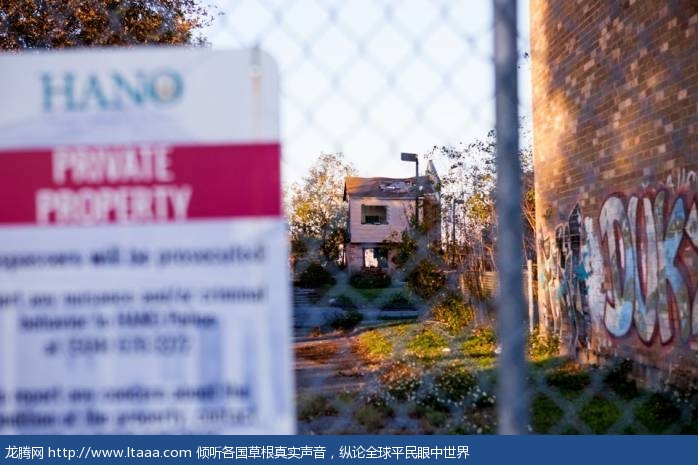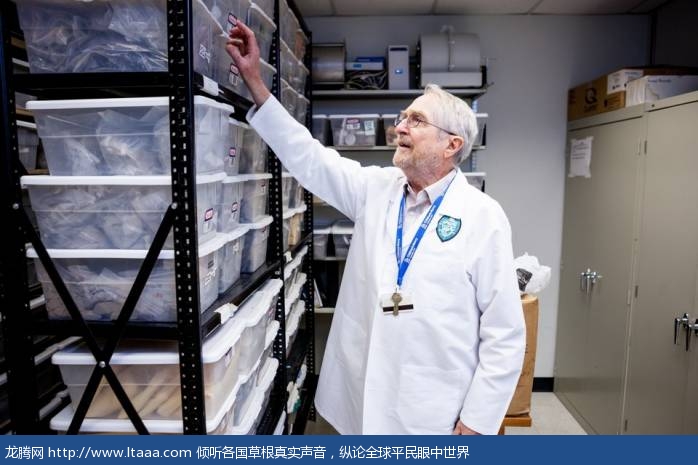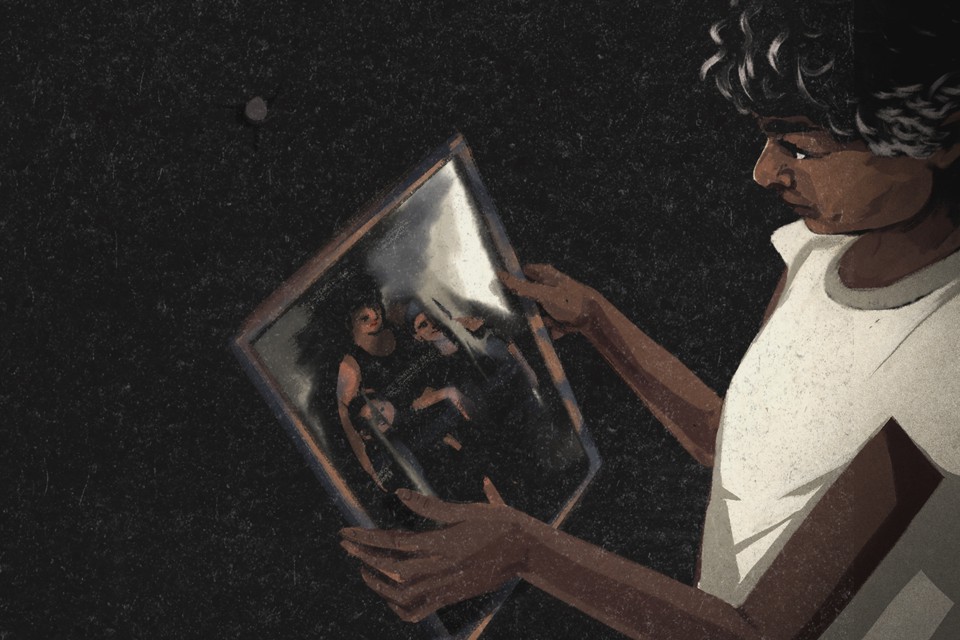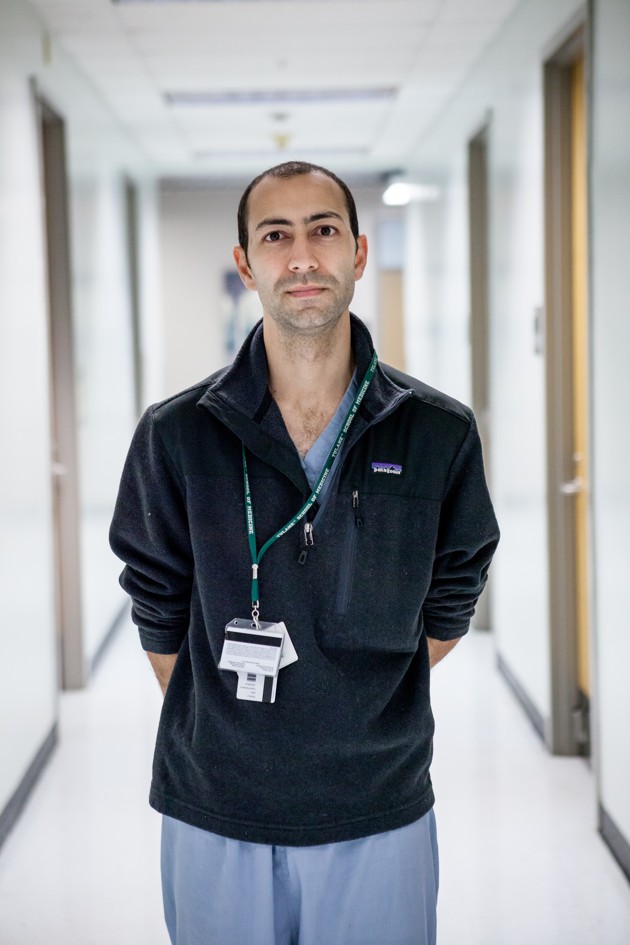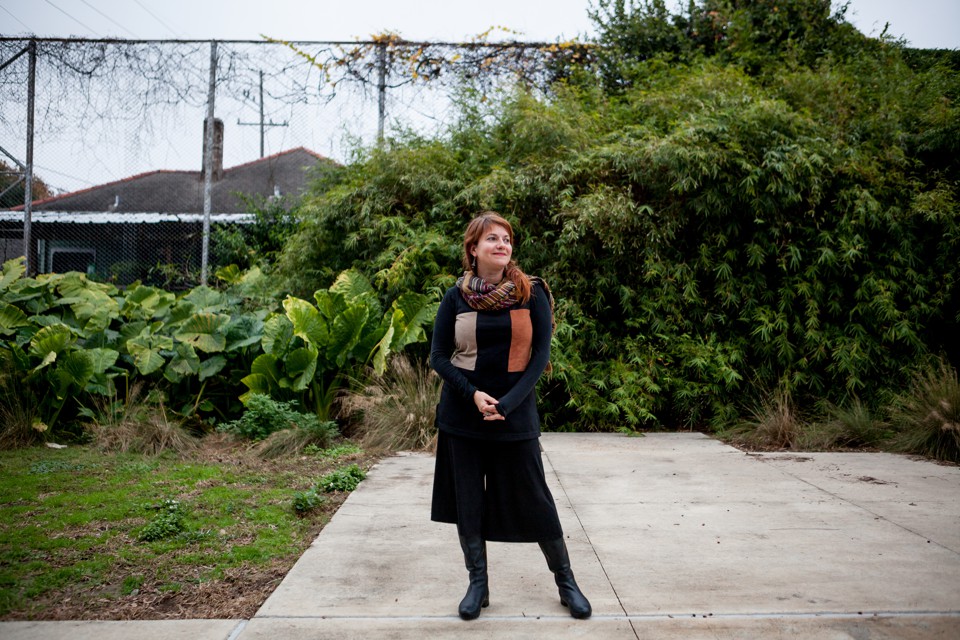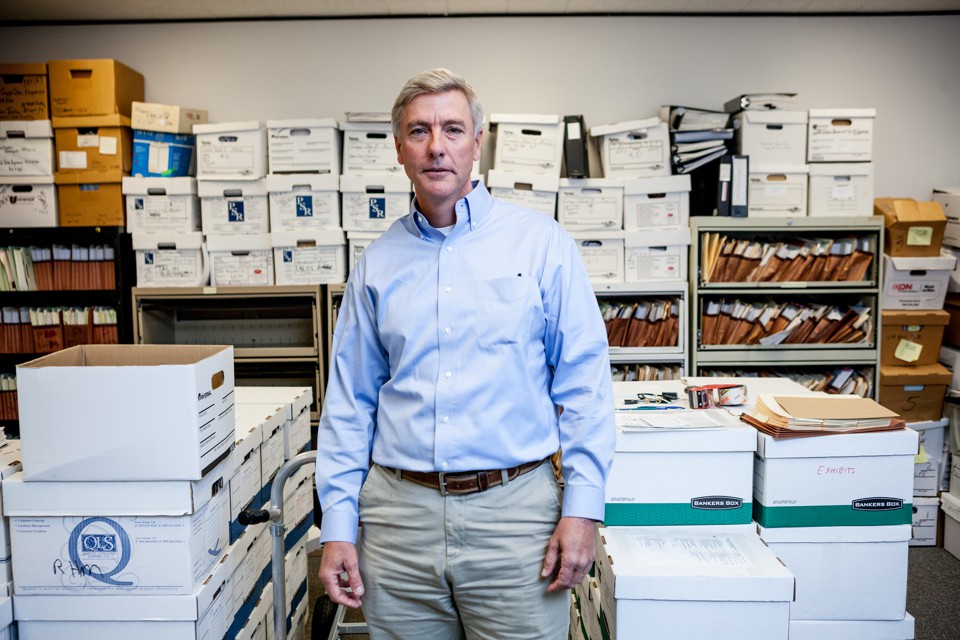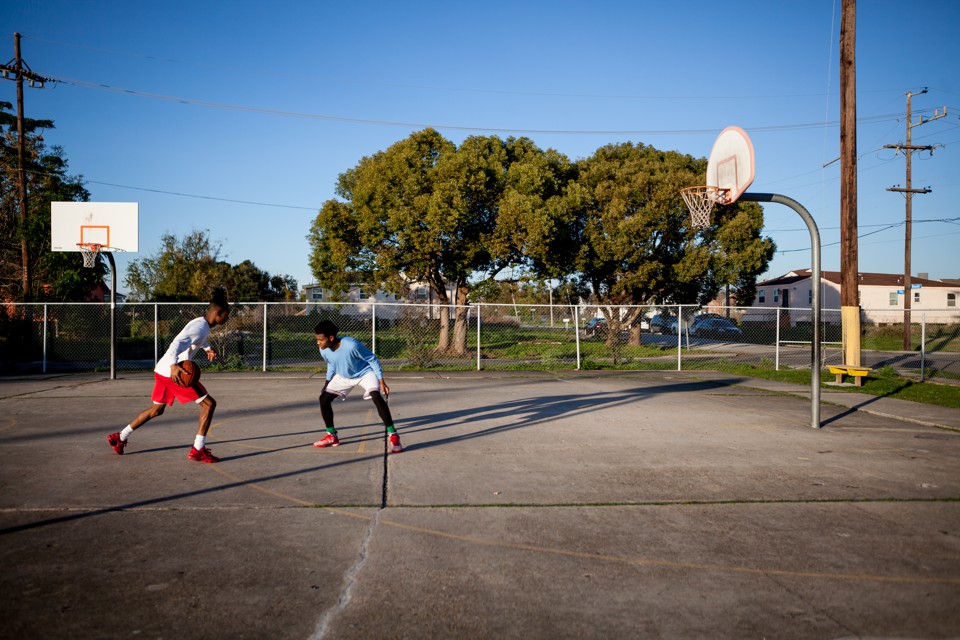【大西洋月刊】中毒的一代 [美国媒体]
新奥尔良市历经数十年的铅中毒诉讼揭露了黑人家庭和社区是如何被毒物破坏的。CASEY BILLIESON曾与整个世界对抗。Casey Billieson背负着与许多母亲同样的重担:尽其所能为两个儿子创造光明的未来,然而她面对的困难是异乎寻常的......
The Poisoned Generation
中毒的一代
The story of a decades-long lead-poisoning lawsuit in New Orleans illustrates how the toxin destroys black families and communities alike.
新奥尔良市历经数十年的铅中毒诉讼揭露了黑人家庭和社区是如何被毒物破坏的
CASEY BILLIESON WAS fighting against the world.
CASEY BILLIESON曾与整个世界对抗。
Hers was a charge carried by many mothers: moving mountains to make the best future for her two sons. But the mountains she faced were taller than most. To start, she had to raise her boys in the Lafitte housing projects in Treme, near the epicenter of a crime wave in New Orleans. In the spring of 1994, like mothers in violent cities the world over, Billieson anticipated the bloom in murders the thaw would bring. Fueled by the drug trade and a rising scourge of police corruption and brutality, violence rose to unseen levels that year, and the city’s murder rate surged to the highest in the country.
Casey Billieson背负着与许多母亲同样的重担:尽其所能为两个儿子创造光明的未来,然而她面对的困难是异乎寻常的。一开始,她就不得不在Lafitte住房项目社区(新奥尔良市公共住房项目之一,公共住房是由政府为低收入者建立的居住设施)抚养孩子,这里靠近新奥尔良犯罪高发核心地区。1994年春季,像其他生活在暴力充斥城市的母亲一样,Billieson预感到了即将到来的犯罪浪潮。毒品交易横行、警察腐败残暴、谋杀率全美第一,新奥尔良当年暴力之泛滥令人触目惊心。
Four hundred and twenty four people were slain in New Orleans in 1994, a murder rate that may have been the highest ever in any American city. Rival drug dealers killed each other while cops killed witnesses and whistleblowers in plain sight. Almost 1 percent of all young black men in the city were killed that year. Many of those murders were committed in the yards and units near where her sons, Ryan and Ronnie—then aged 5 and 3 years old—played or stayed with relatives and friends. Even as a Bill Clinton-led federal government used popular fears of “superpredators” to redouble the nation’s commitment to mass incarceration, Billieson attempted the superhuman task of trying to provide her children with a way out of Lafitte.
1994年,新奥尔良市有424人被杀害,这可能是美国史上最高谋杀率。贩毒团伙之间战火纷飞,而警察公然杀害目击者和举报者。将近1%的黑人青年死于非命。许多谋杀就发生在她所在社区附近,她5岁的儿子Ryan和3岁的Ronnie 生活在亲友圈的保护下。尽管联邦政府设法通过大规模监禁来降低犯罪率,Billieson 依然要尽其所能保护她的孩子免受伤害。
But the obstacles for a young mother and her two children ran deeper than the onslaught in the streets. “They played inside a lot,” Billieson said, “and we thought they’d be safe that way, but then we learned even that was bad for them.”
但这个年轻母亲和她两个儿子面临的障碍远不仅是街头犯罪。“孩子们大多时间待在家里” Billieson 说,“我们原以为那样更安全,后来才知道并非如此。”
Inside the apartment, her boys were insulated from the crossfire outside. But like thousands of others seeking shelter behind the peeling walls muffling the bubbling bass dripping from Crown Vic speakers, the poison of lead would find a way into her sons’ bodies all the same. Ryan and Ronnie, along with thousands of other poor children in New Orleans whose parents believed they could shelter their children from the violence outside, would become an entire poisoned generation.
虽然公寓可以将外面的交火隔绝开,然而那斑驳破旧的墙壁无法阻止铅毒入侵孩子的身体。Ryan、Ronnie 和新奥尔良市成千上万穷人家孩子,是整整一代遭受毒害的人。
Lead was only one of many ecological risks her family faced. The playgrounds where Ryan and Ronnie played often brimmed with pools of fetid, standing water—owing to New Orleans’s fabled and constant flooding—that were sometimes tainted with battery acid. Billieson had heard tell about the regurgitated sewage and chemical waste from Louisiana’s booming petrochemical operations that flowed back into dirt common spaces where her children learned to walk, all while they breathed in the emissions from the nearby roads and highways.
铅仅仅是他们面对的风险之一,Ryan 和 Ronnie 玩耍的场地经常被臭水塘淹没,这些新奥尔良经常性洪水导致的积水,有时会被蓄电池酸液污染。Billieson 听别人说过,路易斯安那繁荣的化学工业排放的污物,经常回涌至地面,她的孩子就在受污染的公共区域蹒跚学步,同时,他们还呼吸着附近道路扩散来的汽车废气。
Some other kids across the virtually all-black New Orleans housing projects had it even worse. That year, the Press Park section of the Desire projects and its nearby elementary school were declared a Superfund site by the Environmental Protection Agency for a concoction of known contaminants leaching from a closed landfill.
新奥尔良住房项目居民几乎全是黑人,有些孩子情况更糟。当年,Press Park 社区和小学因为遭到废弃填埋场的淋滤污染,被美国环保署宣布为超级基金污染场址(美国《环境应对、赔偿和责任综合法》,也称《超级基金法》。美国环保署(EPA)依据《超级基金法》,建立了从环境监测、风险评价到场地修复的标准化管理体系)。
Billieson did her best to protect her boys, and she certainly wasn’t naive about the sicknesses that dogged her neighborhoods. People in the projects were well aware that their environments weren’t healthy, and she went the extra mile; researching the specific risks her kids faced, including those from lead, at the public library. But what do you do when everything is contaminated?
Billieson 尽其所能保护孩子,而且她绝非对危害一无所知,住房项目居民很清楚环境不健康,她甚至还到图书馆查了这些危害的细节。但是,当周遭一切都被污染时,你又能做什么?
Around the time Ryan was entering kindergarten and Ronnie was supposed to be learning how to count to 10, the boys began struggling with the childhood learning goals Billieson set for them. “They had learning disabilities, and when I say disabilities, I mean learning at a slower pace,” Billieson told me. But black kids in the projects were written off and diagnosed with learning disabilities all the time, and good, affordable doctors were scarce. There still wasn’t much even the most diligent parents could do.
当时Ryan 正是上幼儿园的年龄,而Ronnie 应该学会从1数到10。两个男孩开始对妈妈设立的学习目标显出吃力。“他们有学习障碍,我说障碍,意思是他们学得很慢。” Billieson 对我说。不过住房项目的黑人儿童经常被诊断为学习障碍,能让人请得起的医生十分稀少。父母费尽心血也往往束手无策。
One afternoon word spread around Lafitte that a group of white folks—a rarity in any of the projects outside of the occasional housing authority official or police officer—was asking around about lead poisoning. “A lawyer and his team were in the area doing testing on the soil, and I was on my way to the doctor’s office with my kids,” Billieson said. “So I stopped and had a conversation with them about lead poisoning. A suggestion from them was to have the kids tested.”
一天下午社区传言一群白人——除了偶尔出现的项目主管和警官,白人可是稀客——正在走访调查铅中毒问题。“一个律师和他的团队在做土壤测试,当时我正要带孩子们去看医生,”Billieson 说,“所以我停下来和他们谈了谈,他们建议给孩子做个测试。”
When the blood came back, Billieson found out that both of her children were poisoned and likely had been for years. In a panic, she called the lawyer who’d left his card with her. That phone call began a legal war of attrition that spanned more than two decades, three presidents, and one of the most devastating natural disasters in American history.
血测结果出来了,Billieson 发现两个孩子都中毒了,而且很可能中毒多年。惊慌之中,她拨通了律师留给她的电话。这通电话开启了一场漫长的法律消耗战,历经20多年、三任总统、还有一场美国史上最严重自然灾害(卡特里娜飓风)。
GARY GAMBEL WAS a young man in 1994. Just a few years past the Louisiana state bar exam, he’d recently helped start the law firm that now sits in the heart of the business district and boasts his name across the front door. He was known among friends and law school classmates for his activist leanings, and those leanings had turned into full-blown fever by the time he met Casey Billieson that spring day and told her to get her kids tested for lead poisoning.
1994年,Gary Gambel 还是个小伙儿,刚通过路易斯安那州律师资格考试没几年,现在他的律师事务所坐落在商业中心声名远扬。他当时在朋友和校友当中以激进倾向而出名,当那年春天碰到Casey Billieson 、让她孩子做铅测试后,这种激进倾向达到了顶峰。
Gambel had been trying to find a way to investigate the lead-poisoning issue in New Orleans housing developments ever since an old associate of his uncovered several positive lead-poisoning tests while working a different case involving public-housing residents.
Gambel 的一个老同事曾在办理案件时揭露过几起铅污染问题,从那时起他就一直设法调查新奥尔良市住房项目的铅污染。
“He called, and he said we had a doctor who works for a medical program in the projects and all these kids are coming in lead poisoned,” Gambel told me. “So I went to go meet them, and I met one mom and then her neighbor.”
“他打电话给我,说有个居民健康计划医生,还说所有孩子都铅中毒了。” Gambel 对我说,“所以我去见了他们,然后碰到一个母亲,还有她的邻居。”
His plan was originally to take some of cases on a pro-bono basis, helping families move out of lead-contaminated homes and pressuring the housing authority into providing them abated or renovated units. But he soon found that just about all the families he spoke to had kids who tested positive for lead poisoning, and the city hadn’t abated any units across its developments. Gambel’s response when realized he’d stumbled onto one of the worst public-health crises in America was one of awe: “I said, ‘God, we need to do something.’”
原本他打算以公益律师身份接几个案子,帮助这些家庭迁出铅污染公寓,向当局施压给他们提供新住处。但是他很快发现,他询问的所有家庭的铅毒测试都呈阳性,政府却没有丝毫作为。当Gambel 意识到自己涉足的案件是美国最大公共健康危机之一时,他的回应是:“老天啊,我们必须要做点什么。”
Even then, dozens of positive blood tests later, Gambel—a business lawyer by training—and his small start-up firm didn’t quite realize the nature of the leviathan they hunted. The Housing Authority of New Orleans (HANO) had been labeled as a “troubled” housing authority by the federal office of Housing and Urban Development since 1979, and by 1994, HANO housing was among the most miserable places to live in the country.
即便拿到大量铅毒测试阳性结果,Gambel ——这名商业律师以及他刚起步的小事务所,依然没有充分认识到他们面对的困难。新奥尔良房屋委员会(HANO)自1979年以来就被联邦住房与城市发展部(HUD)称作“混乱的”。到1994年,HANO成为了美国最痛苦居住地之一。
HANO was once the crown jewel of the mid-20th century program of federally funded public housing. Even at the height of Jim Crow, the well-built HANO projects anchored mixed-class, inner-city black neighborhoods. But the projects had deteriorated since then, aided by white flight, reductions in services, and a backlash against black political power. By the time Billieson was entering adulthood in the late ’80s, the big projects—Calliope, Magnolia, Florida, Lafitte, and Desire—that had once been known as brick bastions of the black working class, were known through hip-hop for bleakness and toughness.
20世纪中期,HANO曾是联邦政府基金公共住房项目翘楚。建造过Jim Crow 这样的混合阶层模范社区。但住房项目自那之后逐渐变质了,服务减少、迁居来的白人发起反黑人政权浪潮。到80年代末期Billieson 成年时,曾被称作黑人工人阶层堡垒的几大住房项目,变成了悲惨的代名词。
HANO authorities simply didn’t respond to thousands of complaints or keep buildings up to code. In 1994, 15 years after HANO was labeled a “troubled” development, HUD inspectors visited 150 units in the neighborhood and found that all 150 units failed to meet standards—with problems including peeling lead paint, asbestos exposure, and massive roach infestations—and that none of the units had been updated at all in 10 years. HUD rates housing authorities on a 100-point quality scale, with a score below 60 indicating a “troubled” development. In 1994, Billieson was raising her boys in a project that had just received a score of 26.
HANO当局没有理会大量投诉,也没有按规定修缮建筑。1994年,HUD督察员调查了150个公寓,发现这些公寓全不合格,问题包括铅涂料污染、石棉污染、蟑螂泛滥等等,这些公寓都10年来没有任何改善。HUD 用百分制给公寓评分,低于60分即被视为“混乱的”。而Billieson 居住的公寓仅得到26分。
There is no safe level of lead in the human body. Even at low levels, chronic exposure can damage the brain and the central nervous system, and can cause symptoms from hearing loss to IQ deterioration to lack of impulse control. Over time, lead gets absorbed into the bones, making them brittle and stunted, and causes teeth to crack and rot. Exposure in young children with developing minds and growing bones is most destructive, and in times of serious stress and trauma—common in places like the New Orleans projects in the 1990s—those effects are magnified. Each poisoned child in HANO dealt with at least some of those issues, many or most of them for life.
人体对铅元素不存在安全剂量,如果长期接触,即便含量很低,也会损害大脑和中枢神经系统,导致听力损失,智力衰退。时间久了,铅会被骨骼吸收,造成骨骼易碎、发育不良,牙龈腐烂。这对发育期儿童来说尤为致命。这些症状在HANO 项目儿童身上非常明显,他们大都受害终身。
The first sign of lead trouble in HANO came in 1985, after the Centers for Disease Control and Prevention set the standard for lead-poisoning intervention at 25 micrograms of metal per deciliter of blood. Kids were regularly testing at levels well above that level across New Orleans in 1985, even more so in the projects. In 1987, a group of residents in the St. Thomas housing development, led by resident Virginia Mitchell, filed a lead-poisoning lawsuit against HANO that was eventually settled with a consent decree demanding HANO take action to abate lead in its units.
1985年,美国疾控中心(CDC)设立了铅中毒起诉标准——每100毫升血液中含超过25微克铅即可视作中毒,人们随即发现了HANO 的铅问题。St. Thomas 社区居民自发成立小组,将HANO 告上法庭,最后双方达成和解,要求HANO采取措施治理污染。
HANO did nothing, and the trickle of complaints became a deluge in 1991, after the CDC decreased its actionable guidelines for lead exposure from 25 to 10 micrograms per deciliter of blood. According to a 1993 Government Accountability Office report, “during 1991 the New Orleans Housing Authority settled over 60 lawsuits that cost over $1 million in claims and attorneys’ fees.”
然而HANO 什么也没做。1991年,CDC把起诉标准从25微克降到了10微克,人们的愤怒达到了顶点。1993年政府问责报告中称:“1991年一年内,HANO吃了超过60个官司,赔偿超过1百万美元。”
The onslaught of lawsuits was such that HANO lost its ability to secure commercial liability insurance. HUD forced the city to cede control over the HANO developments to a succession of private third-party managers who still couldn’t get a handle on lead poisoning. The city-appointed board and the managers squabbled constantly, according to federal oversight reports.
大量诉讼让HANO声名狼藉,甚至没有商业保险公司愿意接单。HUD命令HANO将管理权委任给第三方私人组织。然而铅污染问题依旧没有改善,委任的董事会和管理层经常吵得不可开交。
While Gambel was looking for potential plaintiffs, HUD declared HANO in breach of its contract and stepped in to create an oversight agreement. The scandals regularly made national news outlets. A Washington Post article from April 1994 quoted the former HANO managing director Shelia Danzey: "I don't see the light at the end of the tunnel for at least five or six years, and that's a light that is pretty dim.”
正当Gambel 寻找潜在客户时,HUD宣布HANO违反条约,并介入监督。这些丑闻经常出现在媒体头条,1994年4月华盛顿邮报一篇文章引用HANO前主任Shelia Danzey 的话说:“过去5、6年我看不到什么希望,即便有也非常渺茫。”
Dilapidated homes remain fenced off by the Housing Authority of New Orleans near the Desire Development Area. (Claire Bangser)
Desire社区附近被HANO隔离的废弃房屋
It’s no surprise then, that a legion of lead-poisoned black residents in the New Orleans projects had answered Gambel’s summons, most of them concerned mothers and their affected children.
考虑到所有背景,新奥尔良市遭铅中毒的黑人居民响应Gambel 号召就一点不奇怪了。他们中大部分是焦虑的母亲和受影响的孩子。
There were Billieson and her two sons. There was Sheila Green in Lafitte, whose twin sons, Ronald and Donald, tested well over the 1991 lead guidelines, with one son receiving almost four times the legally actionable amount and exhibiting hyperactivity and multiple learning disorders. There was Joyce Galmon in C.J. Peete Housing, whose four kids had speech problems. There was Detress Lewis, also in C.J. Peete, whose two children had blood-lead levels twice as high as even the looser 1985 guidelines, and whose complications were so severe that they had to be hospitalized.
这里面就有Billieson 和她两个儿子,以及Sheila Green ,她一个孩子血铅含量超过标准4倍,有严重的认知障碍。Joyce Galmon 四个孩子都有语言障碍,Detress Lewis 两个孩子超标两倍,严重的并发症迫使他们住院治疗。
Hundreds of women who’d been born in the projects and poisoned with lead their whole lives passed metals in utero to their children, whose first breaths took in clouds of white leaden dust. Lead levels per deciliter of blood among the plaintiffs regularly measured in the 20- to 40-microgram range, with spikes above 50 micrograms. (The water-contamination crisis that began in Flint, Michigan, in 2014 was triggered by blood-lead levels over the current upper limit of five micrograms per deciliter.)
成百上千的女性出生在受污染社区,她们的孩子也因为血液传递而遭受毒害,原告的血铅水平通常在20到40微克之间,最高的超过50。(作为对比,2014年密歇根州水污染导致的铅中毒危机,当时铅上限标准是5微克。)
“I had to get involved,” Billieson told me. “When I looked at the flyers and the books, I knew it was life or death.”
“我必须做点什么,” Billieson 告诉我,“当我看到名单和数据时,我意识到这是生死攸关。”
NEW ORLEANS PROBABLY won’t ever face a lead-poisoning crisis nearly as bad as the HANO episodes of the ’90s. But an understanding of just how toxic the substance is has risen over the past few years, even as science has revealed the sheer ubiquity of its remnants in places as disparate as Los Angeles, Flint, and Baltimore.
新奥尔良从未经历过像 HANO事件那样严重的铅中毒危机。近些年,随着科学研究发现铅残留在洛杉矶、弗林特、巴尔默特等地普遍存在,公众对铅的危害也愈加了解。
For some HANO kids, even the stability of a fast-food job is permanently out of reach. Marcel Coleman—one of the then-infant plaintiffs in the Billieson court dockets—was shot and killed in the Florida neighborhood in 2015. Among the leading plaintiffs, Ronald Green was also killed, and many others didn’t make it to see the settlement. Some of the young men—made turbulent, their mothers claim, from the lingering effects of lead—who should have collected settlements missed out, locked away in places with names like Angola, Dixon, and Elayn Hunt.
对很多HANO 孩子来说,即便一份快餐业的稳定工作也是遥不可及的。Marcel Coleman——Billieson 诉讼原告婴儿之一,2015年被枪杀。许多人都没活着看到处理结果。其中许多年轻人制造了骚乱,她们的母亲声称,因为铅中毒挥之不去的影响和久拖未决的处理,他们只能被关在Angola、Dixon、Elayn Hunt 之类的地方(矫正中心)。
For each of these missing victims, the unasked question is the same: How much of a role did lead poisoning play in their fates?
I spoke to Howard Mielke at his lab at the Tulane Medical Center. Mielke, a geographer and environmental researcher, is one of the most prominent lead-poisoning experts in the country, has dominated the lead-poisoning research in New Orleans for years.
每个受害者都有一个同样的问题:铅中毒究竟多大程度上改变了他们的命运?
我在杜兰大学医学中心和Howard Mielke 进行了交谈,他是地理学家和环境学家,也是美国最着名的铅中毒专家,多年来主导着新奥尔良铅中毒研究。
In 2012, Mielke and co-author Sammy Zahran examined crime—specifically aggravated assault—in six cities, including New Orleans, and its relationship to lead in gasoline emissions. Their results were startling: Increases in lead aerosols were strongly associated with increased crime, and according to their research, differences in lead levels accounted for about 90 percent of the variation in crime between the six study cities.
2012年,Mielke 和Sammy Zahran 合作研究了包括新奥尔良的六个城市的犯罪率——尤其是严重伤害罪,和汽油铅排放量的关系。结果是令人震惊的:含铅气溶胶量的增加和犯罪率增加有很强的相关性,相关性高达90%。
Howard Mielke looks at soil samples in his lab at Tulane University School of Medicine. Mielke, a research professor in the pharmacology department, researches the causes and impacts of lead contamination. He was an expert witness in the Billieson v. City of New Orleans case. (Claire Bangser)
Howard Mielke查看他在杜兰大学实验室中的土壤样本,他是药物学系教授,研究铅污染的起源和影响,他是Billieson 案件中的专家证人
The lead-crime conundrum is a relatively recent addition to the sociology of crime. In early 2016, Kevin Drum of Mother Jones detailed the chronology of this line of research, which actually starts in 1994. Rick Nevin, a HUD consultant on the risk-impact analysis for lead-paint reduction rules, developed a hypothesis that the main societal cost of lead poisoning was its effect on crime, mediated through its cognitive effects on boys and young men. That hypothesis was expanded by Amherst College researcher Jessica Wolpaw Reyes, who identified critical pathways of the potential effect—with juvenile delinquency, ADHD, and low IQ connecting populations of young black men to ultimate criminal outcomes and incarceration.
在犯罪社会学研究中,铅—犯罪关系是比较新的命题。2016年初,《琼斯母亲》专栏作家Kevin Drum 详细介绍了该研究的历史。1994年,HUD顾问Rick Nevin 提出假设,铅中毒造成的主要社会影响,是影响青少年认知能力从而导致犯罪增加,阿默斯特学院研究员Jessica Wolpaw Reyes丰富了该假设,他提出了影响的具体方式——青少年犯罪、注意力障碍、低智商共同导致黑人青年的高犯罪率和入狱率。
Enthusiasm about the lead-crime hypothesis has been blunted by recent research. A 2015 report from the Brennan Center on factors that caused the decline in crime since the ’90s calls the hypothesis “controversial,” and notes that some elements of Reyes’s work have been difficult to reproduce, although it does list lead poisoning as one of 13 possible crime factors in the decade. A study that same year by researchers Janet Lauritsen, Maribeth Rezey, and Karen Heimer also did not find a significant correlation between lagged lead poisoning and homicides using a different dataset.
但铅—犯罪研究热度近年有所下降,2015年布伦南中心的一份报告称,90年代以来逐渐下降的犯罪率证明该假说是“有争议的”,虽然Reyes把铅列为13种犯罪因素之一,但他的实验结果很难重现。另一批研究者使用不同数据在同年展开的研究,没有发现铅中毒和谋杀之间有显着关系。
Even if lead plays a smaller role in crime outcomes than Mielke, Nevin, and Reyes suspect, it’s possible that it contributed to the most violent time and place the country has ever seen, especially given the extremes found in HANO. What’s known without a doubt is that communities don’t thrive when poisoned, regardless of whether that poisoning is the disease or just another symptom.
即便铅中毒的影响比某些学者猜想的小,铅也很可能是那段前所未有的暴力时期的促成因素。我们所能肯定的是,一个中毒的团体不会兴旺。
Now, even as the White House pursues the marginalization of the EPA, HUD, and lead-remediation programs, familiar alarms sound in places like East Chicago and in Flint, where the water is still not quite safe to drink.
现在,白宫正试图边缘化EPA、HUD、铅修复项目,与此同时,像东芝加哥、弗林特这样的地方的水依然不安全,人们依然生活在警报之中。
THE MERITS OF the plaintiffs’ cases against HANO seem obvious in retrospect, but their battle was not destined to be easy, nor would it guarantee them better lives.
在对HANO的诉讼中,原告的优势似乎是不可阻挡的。然而事实是,他们的战斗注定不简单,也无法保证更好的生活。
For starters, when Gambel took on the cases it was near-impossible to settle with HANO or receive any money from judgments against them, since they didn’t have any liability insurance. Plaintiffs could technically win, and often did, but since they couldn’t exactly seize a public-housing authority’s assets in cases of nonpayment, they often won big fat piles of nothing.
首先,当Gambel 接手这个案子时,几乎不可能和HANO达成任何赔偿和解,因为没有保险公司给他们提供保险。原告们经常在法律层面上胜诉,但判决书是一纸空文,因为即便委员会拒赔,他们也无法逮捕任何官员。
"When I filed that lawsuit, in hindsight I was just naive,” Gambel said. “As a young lawyer and a start-up firm, there were a lot of people asking me, ‘How are you going to do this?’”
“事后来看,当时我还是太年轻了,” Gambel 说,“作为一个年轻的、事业刚起步的律师,当时许多大佬问我‘你有什么金刚钻?’。”
It helped that Gambel’s work had attracted the interest of lawyers from other firms that had experience suing HANO. Among them was Joe Bruno Sr., a trial lawyer known for taking on huge cases. In contrast to Gambel, then a fledgling business lawyer at a small firm with an environmentalist streak, Bruno was television’s idea of a lawyer, and he was known even then for taking on big cases against big companies after big disasters.
所幸Gambel的工作吸引了不少有HANO诉讼经验的同行,辩护律师Joe Bruno Sr. 是专接大案的大佬,相比Gambel 这种乳臭未干的菜鸟,Bruno是电视偶像的存在。
Bruno had represented one of the earlier plaintiffs in a lead-poisoning suit against HANO, in which a judge handed down a million-dollar judgment that the plaintiff couldn’t collect because of insufficient liability coverage. But his approach informed the gambit the plaintiffs needed to try to be able to recoup something. In that first case, Bruno’s team had found that HANO’s private-property manager had a limited pool of liability insurance and could be successfully sued.
Bruno曾接受过一个HANO案子,法官判了上百万的赔偿,超过了承保范围。但是他的手段让原告看到了希望,Bruno团队发现HANO的私人财产管理部门有一个保险资金池,最终被成功执行赔偿。
By the time the Billieson-led plaintiffs filed suit, HANO was run by the private-management company C.J. Brown, which had liability insurance from a few different companies. C.J. Brown was contracted by the city of New Orleans under HUD’s directive to clean up the crumbling housing developments, but their method of doing so actually made the lead problem worse and, in turn, made them potentially liable for poisoning hundred of people.
Billieson 案件中,HANO当时已被私人管理公司C.J. Brown 接管,这家公司有好几份商业险。HUD指定该公司处理住房项目问题,但是他们的处理措施反倒加重了铅问题,所以,他们是个潜在的赔偿来源。
“C.J. Brown wanted to go in and renovate whole sections of development instead of constant abatement and maintenance all over,” Gambel told me, “which led to a sliver of the units getting a lot better while most of the rest got worse.”
“C.J. Brown 公司插手后想把住房项目推倒重来,而没有稳步改善、减少(问题),” Gambel 对我说,“结果是极少部分人获益,大部分情况更糟了。”
"My thinking was that if you could get an enormous judgment against them, maybe with the pressure, HUD might fund it,” he said. “And let's be realistic: Cases get settled because of pressure. The defendant believes that if they proceed to trial, they're likely to pay more money than if they settled the case."
“我的想法是,如果能庞大的诉讼向他们施压,那么他们的上级,HUD可能会拨款,让我们现实点吧:只有施压事情才能得到解决,被告会感觉拖下去会花更多钱,不如早点妥协。”
HANO cases and suits for a raft of different issues, including lead poisoning, were so backed up that the Louisiana Supreme Court had to appoint a special judge to handle them, Judge Joe DiRosa. The first step for the team of lawyers required establishing damages to a whole class of kids, and liability on behalf of HANO, C.J. Brown, and the contractors they used.
HANO案件包括铅中毒等一系列问题,该案件得到的呼声是如此之高以至于路易斯安那州最高法院不得不指派一个特别法官——Joe DiRosa 来审理。律师团队第一步要求先全面评估孩子们的伤害状况,以及HANO、C.J. Brown公司和他们使用的建筑承包商的责任。
There was clearly lead paint, not only in the housing units, but peeling in common areas like stairwells and around outdoor rails. But it turns out that paint was only one avenue by which children in HANO projects were being exposed to lead. HANO lawyers brought forward Mielke to testify as an expert witness. His research indicated that much of the lead in the inner-city’s soil near roads and highways came from leaden fumes deposited by automobiles in the decades before the stuff was banned from gasoline, although not from the home.
铅涂料是一个显而易见的因素,屋内装修和公共设施都有。但铅涂料只是接触源之一。律师团队提请Mielke做鉴定证人,他的研究指出城市中公路附近土壤中的铅,大部分来自长期以来机动车含铅燃料排放。
“In the Billieson case, I looked at it differently from the people saying it was all lead-based paint,” Mielke told me. As a crusader against soil-based lead poisoning and its connection to automobiles, Mielke said his testimony was not that the children of HANO weren’t damaged nor that they didn’t deserve recompense, but that the plaintiffs had gotten at least some of the causality wrong.
“在Billieson 中,人们都说铅污染全部来自涂料,我与他们看法不同,”Mielke 对我说,作为反土壤铅污染的改革者,Mielke 说他的证词并不意味孩子们没有受到伤害或不应得到赔偿,而是原告们多少搞错了因果关系。
The trial court originally denied the class-action certification based on that testimony and the murky nature of the “constellation of factors” contributing to varying individual levels of lead poisoning. But on appeal, a judge found that pieces of Mielke’s testimony actually helped established culpability for HANO, because HANO was still responsible for abating and cleaning lead in the soil. “Mielke was a great guy, and he really cares about this stuff,” recalled Gambel. “And I think his testimony actually showed how bad we needed to do something.”
初审法庭最初驳回了集体诉讼,理由就是这份专业证词,以及导致不同个体铅中毒水平的“多种因素”的模糊性。但在上诉法庭中,一个法官发现,Mielke 的证词其实能证明HANO的过错,因为HANO有责任减少、清除土壤中的铅。
The appeals court finally certified as a class the children who lived in the HANO projects during C.J. Brown’s management at some point between birth and the age of 6, but still the saga dragged on. DiRosa died in 1997, and a succession of ad hoc judges was appointed by the state Supreme Court to replace him. For the next six years, Billieson et. al v. City of New Orleans languished between courts.“We put this case together for trial over 20 times,” Gambel said.
上诉法庭最终认同了C.J. Brown 公司管理HANO项目期间年龄在0~6岁的孩子们的诉讼主张。然而好事多磨,DiRosa (即前文特别法官)在1997年过世了,高等法院指派了一些临时法官替代他。在接下来的6年间,Billieson 们在和新奥尔良市的战斗中疲于奔命。
As the case continued, the issues of lead poisoning and other environmental dysfunctions in the HANO projects continued unresolved. Even though the pressure on HANO from the lawsuit spurred a limited campaign of lead abatement in the projects, kids still showed up poisoned at doctor’s visits. For seven years after Gambel and Bruno’s team filed the lawsuit in district court, the lead levels in homes and in children’s blood remained high enough to qualify them to join the class.
案件如火如荼,而HANO铅中毒和机能障碍问题依然没有解决。受案件压力,HANO开展了有限的铅治理项目,孩子们依然显示出中毒症状,在Gambel、Bruno团队提起诉讼7年后,孩子们的血铅水平依然足以加入到集体诉讼中。
As the list of plaintiffs compounded, Gambel and the other lawyers who frequently visited plaintiffs and advocated on their behalf became known to the residents of the HANO housing developments as “the babies’ lawyers,” although the people they represented stopped being babies long before the case approached resolution. Those children had children, and those children grew up in those same projects. The group of mothers who’d led the charge against HANO as young adults themselves began to watch a generation of their grandchildren grow up in their homes and choke on the same lead dust.
随着原告规模越来越大,Gambel 和其他律师经常拜访原告和为他们发声的行为在HANO居民中声名远扬,他们被称为“‘婴儿的’律师”。虽然他们的委托人在案件接近解决时早已成年,但当年的这些孩子也有了孩子,他们的孩子在同样的社区长大,那些曾经的年轻母亲,目睹了孙辈出生,然后吸入着同样的铅尘。
Billieson did what she could, even though the plaintiffs were rarely actually called to court to testify. “I did so many depositions, and it still took years and years,” she told me. It seemed to her, like it seemed to most of the HANO residents, that the cycles that kept them bound to the poisoned lands of the generations before them would never really change.
Billieson 尽力了,虽然原告很少被传至法庭作证,“我做了那么多口供,案子依然年复一年拖着。”她告诉我,在她和大部分居民看来,将他们一代代人束缚在中毒土地上的命运怪圈,永远不会改变。
Then in August of 2005, walls of water from Hurricane Katrina buckled the Louisiana levees and destroyed everything.
直到2005年8月,卡特里娜飓风的巨浪冲垮了路易斯安那州防洪堤,摧毁了一切。
AFW OF THE places the denizens of HANO escaped still stand, walled off by barbed wire. Press Park is a ghost town of brick monoliths, with each building marked by the hand of God in a green high-water mark and by the hand of humans in sprawling graffiti, with some characters stretching over 20 feet tall. The old industrial red-brick Moton Elementary stands sentinel behind them, an eerie malevolence of ivy curtains, skittering rats, and broken windows.
如今居民已经离开了,但HANO建筑依在,被铁丝网封锁起来的废墟荒芜破败、锈迹斑斑、老鼠横行,纪念着让人毛骨悚然的往事。
When the surging floodwaters broke through the Industrial Seaway and Lake Pontchartrain, they didn’t single out races or neighborhoods to target. The city and its layers of segregation and poverty did the job of assigning victims themselves. Housing discrimination in the city had forced generations of black residents into segregated wards and neighborhoods, often located in the areas with the highest risk for both lead poisoning and flooding.
当湍急的洪水扫过城市时,大自然并没有针对某一个种族或社区。而人类自身根据种族和财富指定了受害者。这座城市的居住隔离强迫黑人居住在一起,那些社区大多位于铅污染和洪水风险最高的地区。
The resulting destruction was more thorough and more devastating than any single incident of racial violence or hatred. One statistic about Katrina helps put things into context: A Brown University report showed that the most damaged areas in the city were 75 percent black, while undamaged areas were only 46 percent black. And some of the most thorough and permanent depopulation in the city came in the HANO “Big Four” projects—C.J. Peete, St. Bernard, Lafitte, and B.W. Cooper. Casey Billieson and her two boys—then teenagers—escaped the chronic horrors of Lafitte by fleeing an acute catastrophe.
这场灾难比任何种族暴力和仇恨来得都彻底。布朗大学的一份灾情报告显示,受灾最严重的地区75%是黑人居民,未受灾地区仅有46%的黑人,某些伤亡最严重的地区,来自于HANO“四大金花” C.J. Peete、St. Bernard、Lafitte、B.W. Cooper(社区名),Casey Billieson 凭着这一严重灾难,才得以逃离噩梦。
Black people generally were much more likely than white counterparts to be “Katrinaed,” and only around 44 percent of them returned within a year. The black Katrina diaspora mostly bounced around cities in the South—Houston, Baton Rouge, Dallas, Birmingham, and Atlanta—and among them were most of the residents of HANO and the plaintiffs in the Billieson lawsuit, many of whom had never before left the city.
黑人相对白人普遍更容易“卡特琳娜化(代指卡特琳娜飓风受害者或移民)”,他们中只有44%一年内返回家园,很多都移居到了南边城市,休斯顿、巴吞鲁日、达拉斯、伯明翰、亚特兰大。Billieson 案件中的大部分原告都在其中,他们中很多人从未离开过新奥尔良。
Billieson found herself in plenty of different cities across Texas and Louisiana, and other plaintiffs wound up in places like Nashville, Tennessee, or as far off as Chicago. By the time the city began a rebuild in earnest after the flood, HANO residents had been displaced to 36 states, and many were simply unreachable. Seventy-five thousand black people never returned to the city, and its strong majority of black residents has declined since.
Billieson 辗转于许多城市,其他原告也各奔东西。当新奥尔良真正开始重建时,HANO居民分散到了36个州,许多人都失去了联系。7万5千个黑人再也没有回去,自那以后,这座城市的主要黑人群体就衰退了。
The HANO residents who did want to return found a city that seemed intent on moving on without them. With most of their residents displaced to other cities, and with hundreds of units that had been destroyed or damaged beyond repair, the city council voted in 2007 to demolish many of the HANO projects and rebuild them with a mixed-income housing system supplemented with a Section 8 private-voucher system. The stated purpose of the plan was to help fix the worst problems with racial segregation and lead-paint issues in the units.
那些想回家的HANO居民,却发现这座城市不在意他们了。因为大部分HANO居民都移居他地、大量设施被破坏且无法修复,2007年市议会投票决定拆除大部分HANO项目,重建不同收入阶层混合居住的住房体系,并提供完善保障。该计划的目的是解决最严重的种族隔离和铅污染问题。
The rebuilt units in places like the Desire neighborhood look like little slices of subdivided suburbia now, complete with swimming pools and basketball courts. But, as the wide, empty swathes of green and the patches of barren concrete foundations that surround them indicate, New Orleans simply didn’t rebuild nearly enough units, and in some places, the public-housing capacity only rebounded to 10 percent of its pre-Katrina levels.
重建的社区看起来很精致,有游泳池和篮球场。但是周边大片的绿化带和地基显示了,新奥尔良没有重建足够的社区,有些地方容纳量只有灾前的10%。
As a result, Billieson and many of the other black folks who were “Katrinaed” simply couldn’t make it back to New Orleans proper. The vouchers they received for assistance in renting homes in mixed-income neighborhoods didn’t always work out—especially when expenses like utilities aren’t covered—and discrimination often reared its ugly head again when black renters tried to find homes in mostly white neighborhoods.
因此,Billieson 和其他受灾黑人没办法回家乡。政府发放的租房代金券在混合收入阶层社区并非总能起效,尤其是补贴没有覆盖水电费之类。而黑人想在白人社区租房的话,依然要面对各种歧视。
With most of their old homes demolished, and barred from the areas of New Orleans that were actually investing in recovery, many of the former HANO residents who did return were forced to live in homes in the suburbs or on the outskirts of the city, in places like the outermost reaches of Eastern New Orleans, Metairie, LaPlace, and a collection of towns along the West Bank of the Mississippi. Casey Billieson lives in LaPlace now and told me that the place is “full of people who came from where [she] came from.”
因为绝大部分老房都被毁掉或拆除,同时还被禁止居住在政府大力投资的重建区,许多回乡的前HANO居民被迫居住在郊区或郊外。例如最边缘的密西西比河西岸沿岸的Eastern New Orleans、Metairie、LaPlace等,Casey Billieson 现居住在LaPlace,她告诉我,那儿到处都是和她同样出身的人。
Just a few years after Katrina, New Orleans had transformed to an emblem of the reverse white flight and suburbanization of poverty seen in many American cities over the past decade. Old neighborhoods in the part of New Orleans’s black belt like Treme gentrified. And as recent research from Mielke shows, the resettlement of the city by those fortunate enough to be allowed in was aided by the floodwaters having washed away lead-polluted soil.
卡特琳娜飓风几年后,像过去几十年许多美国城市发生的那样,新奥尔良变成了白人迁移和郊区贫困化的标志,而老黑人社区中产阶级化了。正如Mielke 的最近研究指出,那些有幸重新在新奥尔良定居的人,要“感谢”洪水冲走了铅污染土壤。
Nabil Baddour, pictured here at Tulane Medical School, helped start NOLA Unleaded, a New Orleans concerned-citizens organization that addresses lead poisoning in children. (Claire Bangser)
Nabil Baddour摄于杜兰大学医学院,他协助成立了NOLA Unleaded 组织
In the boom in environmental and public-health awareness after the flood, the city also began responding to lead-poisoning incidents with much more vigor. Andy Young was part of a wave of young people who managed to move into the Bywater neighborhood just after the storm, during “that weird spot in time when they would still give credit to the likes of us and we could afford housing down here,” as she recalled. In the legacy housing that stood not too far from some of the most lead- and crime-riddled pieces of the old New Orleans, parents still had to be on high alert.
随着洪水过后环境和公众健康意识的觉醒,新奥尔良也开始投入更多精力解决铅中毒案件。Andy Young 就是觉醒青年之一,她回忆道:“在那个年代,他们还多少尊重我们,我们也还买得起房。”然而即便经历过洪水的冲刷,生活在曾经铅污染、高犯罪地区的父母们,依然高度警戒。
When Young’s children and several other children in the neighborhood tested positive for lead, concerned parents and former city health-education coordinator Nabil Baddour joined forces to form the organizing group Nola Unleaded. With assistance from Howard Mielke, the group pushed for lead testing in the neighborhood playground, Markey Park. In 2010, under Mayor Mitch Landrieu and then-Health Department Commissioner Karen DeSalvo, the city agreed to not only remediate Markey Park, but to test all of the public parks in the city and remediate those that failed. This group of concerned parents, at least, had managed to make the city listen, and they found the truth of the matter: Lead remediation is pretty easy for a motivated city with resources.
当Young 的孩子和其他几个孩子血铅测试呈阳性时,忧心忡忡的父母和前市健康教育协调员Nabil Baddour ,在Howard Mielke 的协助下共同成立了Nola Unleaded(无铅新奥尔良)组织,该团体推动了社区广场的铅检测。2010年,在市长Mitch Landrieu 和时任卫生部门专员Karen DeSalvo 的努力下,该市同意检测所有公园,并治理不合格者。这个平民团体,最起码努力让城市倾听了他们的声音,而且他们发现:如果政府乐意提供资源,那么铅治理是一件很简单的事儿。
Andy Young stands in Markey Park. After learning that her children had high levels of lead in their blood, Young worked with NOLA Unleaded to advocate for lead remediation in Markey Park, which reopened in 2013. (Claire Bangser)
Andy Young 摄于Markey Park
The swift response from the New Orleans health department surprised many of the Bywater parents. As Young told me: “Nothing moves quickly here. Nothing. Except for gentrification. Other than that, actually fixing stuff? Doesn't happen." But the city had found a way of working for its post-Katrina denizens, even as many of those washed away by the flood still languished in court.
政府的迅速回应令许多市民吃惊,Young 对我说:“我们住的这儿,一切都进展缓慢,除了城市绅士化(Gentrification,城市乡绅化是西方国家再城市化过程中,城市中心区更新(复兴)的一种新的社会空间现象。类似于我国大中城市内的“城中村改造”或“旧城改造”),真正意义上的改善?不存在的。” 但城市终于还是找到了解决途径,与此同时,许多被洪水赶走的原告,依然滞身在法庭上。
There’s a room in Gary Gambel’s office in downtown New Orleans, kept under lock and key and surveilled constantly by a receptionist watching from a citadel-like bureau. The lawyers around the building call it the “lead room.” The entire space is filled with boxes, Polaroids, and files documenting the whole 22-year-long history of Billieson v. New Orleans. More than just a collection of court documents and filings, the place is a warehouse of the things that have been lost since 1994 and of the Wagnerian saga that wound about lives of poison, displacement, and redemption.
在Gary Gambel 在新奥尔良市中心的办公室里有一个房间,保卫严密,戒备森严。律师们称其为“铅屋”,房间里放满了盒子、胶片和文件,记录了22年以来Billieson 案件的历史,这个房间收纳的不仅仅是法庭档案,更是1994年以来逐渐消失的史实记录,像瓦格纳传奇那样的——生活的毒药、妥协和救赎。
In that room, Gambel talked to me late last year about the case that had defined much of his legal career. He’d just finished one of the last major fights in the case, a dispute over a half-million-dollar fee paid by the court to a “special master” appointed to help distribute settlement funds. “It took me 20 years, and I didn't think I'd live to see the end of it," he confessed. Indeed, two lawyers on the defense side and one on the plaintiffs’ side died during the proceedings.
在那个房间里,Gambel 去年给我讲述了这个很大程度上决定了他职业生涯的案件。他当时刚刚结束了案子中最后一个主要诉讼——一笔超过50万美元安置费的发放问题。他坦言:“它花了我20多年,我觉得我不能活着看到它完结了。”事实上,两个辩方律师和一个原告在诉讼过程中过世了。
Gary Gambel stands in a room full of files related to the Billieson v. City of New Orleans case. (Claire Bangser)
Gary Gambel站在满是卷宗的房间里
As the defense ran out of maneuvering room and the hopes of a settlement against HANO grew, the lawyers bickered among themselves about their demands. Gambel wanted to push for a $600 million settlement that would have given the class-action plaintiffs somewhere between $170,000 and $300,000 apiece, but Bruno pushed back and aimed somewhere at or below the $100 million level. Lawyers on both sides worked to hammer out a settlement, a process rife with accusations and continuances.
因为案件久拖不决,律师们都希望尽快结束案子,他们之间也会争执。Gambel 想要一笔6亿美元的和解费,最终分给每个原告17万到30万美元。而Bruno 提出反对,他希望1亿美元左右以尽早达成协议。各方律师都苦心于终结这个噩梦般的案件。
Finally, in 2011 the small armies of lawyers reached terms on an armistice: a $100 million settlement split between $67 million in cash awards and $33 million in housing vouchers to the plaintiffs. Half of the $67 million would go to the affected individuals and the rest would be used for legal fees.
最终,2011年,律师团队达成了共识:1亿美元的赔偿,6700万现金支付,3300万以住房券形式发给原告,6700万现金中一半给原告,一半是律师费。
Still, even with a settlement on the table, the people who had been poisoned by HANO were not much closer to receiving compensation. Katrina had destroyed many of the city’s medical records, thus disqualifying several of the plaintiffs and potential plaintiffs, who had to demonstrate that they had elevated blood levels before the age of 6 in order to receive settlements. The attrition from the storm was indiscriminate. Joan Dominique, who lived in the Desire projects, told me: “My oldest daughter was awarded over $14,000, but they told me my other two children didn’t have records. But they found them in a basement in City Hall later.” There were many other potential settlement recipients across the country, displaced by the storm, whom the city could not reach. The seemingly random assignment of eligibility still incites anger in some communities today.
然而,即便形成了解决方案,受毒害的HANO居民离赔偿金到手依然有一定距离。卡特琳娜摧毁了该市的许多医疗记录,所以部分原告丧失了资质,为获得赔偿,他们不得不证明自己在6岁之前的血铅水平高于标准。飓风的影响是无差别的。Joan Dominique 告诉我:“我的大女儿收到了14000美元赔偿,但他们告诉我找不到另两个孩子的记录,还好后来在市政厅的地下室找到了。”全国各地分散着许多因飓风而迁走的潜在获赔人,新奥尔良无法联系上他们。直到今天,这种在部分社区看来是“随机分配”的赔付方式依然引发着他们的怒火。
When the feeding frenzy among lawyers subsided, what remained for the plaintiffs almost seemed an afterthought. Dominique’s three children received settlement checks of around $14,000. Casey Billieson’s sons, now 27 and 25 years old, and living and working with families of their own in New Orleans, received a total of $35,000. The average settlement amount per person among the 2,000 qualified plaintiffs was $17,000.
当对律师的不满平息后,人们似乎才想起原告的境遇。Dominique 三个孩子收到了大约14000美元的赔偿。Casey Billieson 的两个儿子,现在27岁和25岁,和他们自己家族居住生活在一起,总共收到了35000美元,2000多个有获赔资格原告的平均赔偿金额是17000美元。
After spending months speaking to plaintiffs, I began to suspect there’s very little that New Orleans can ever do to truly compensate them for the terrors they face. Estimates from the CDC put the average lifetime costs for even mild and initially asymptomatic cases of lead poisoning around $50,000, and many of the HANO children had tested for lead levels that indicated immediate medical emergences. Most of the plaintiffs were already too old for the money to help with education, and they’d probably already lost thousands in potential earnings from the psychological and educational effects of lead poisoning.
在花了几个月和原告交流后,我开始怀疑新奥尔良真正能做的补偿实在太少太少。在美国疾控中心估算中,即便是最轻程度的铅中毒,终生医疗费用也要50000美元,而很多HANO孩子情况严重得多。这笔钱本该用来帮助他们的教育,而大多数原告年龄早就过了。更不要说因为铅中毒,他们丧失了多少教育学上和心理学上的潜在收益。
“We did receive compensation, and no, I don’t think it was adequate,” Billieson told me. “I think they could have had more of these kids tested ... They should send us the research [too], because none of us knew anything about lead poisoning, and we didn’t know what the side effects could’ve been.”
“我们确实收到了赔偿,但是,我觉得那远远不够,” Billieson 对我说,“我觉得他们本应检测更多孩子……他们应该提供研究报告,因为当时我们没人了解铅中毒,也不知道会带来什么负面影响。”
Dominique’s anger was more palpable. “I don’t know that you can correct the problem, but we can help [the children] now,” she said to me over the phone. “Buy them homes. Get them educated. These are things they took from these kids. You can never make up the gap, but you can try to do something. And there are funds. The city is still operating.”
Dominique 的愤怒更加直白,“我不知道你们能不能纠正这个问题,但是我们可以帮帮这些孩子。”她在电话中对我说,“给他们提供房子,让他们接受教育,这是孩子们被
夺去的东西,你们不能完全弥补过错,但你们可以试着做点什么,有各种基金,城市还在运转不是么?”
“The award that we received was nowhere near what it needed to be to compensate these kids for their trouble,” she continued. “It just wasn’t enough.”
“我们收到的判决,根本不足以补偿孩子们的问题,远远不够。”
I HAVEN’T BEEN ABLE to reestablish contact with Casey Billieson in the weeks since I left New Orleans. Just after my last visit, a tornado ripped through her town of LaPlace, damaging and destroying hundreds of homes. While nobody was seriously injured, it brought one more round of rebuilding for the community of displaced people now living there.
我离开新奥尔良后的几周时间都没法重新联系上Casey Billieson ,就在我最后一次拜访她后,一个龙卷风袭击了她的社区,造成了上百所房屋损失,虽然没有人严重受伤,但居住在那儿的人又得等新一轮重建了。
The stories of disruptions among the families poisoned in HANO still reverberate. Joan Dominique’s daughter was placed in a similar position after catastrophic floods in Baton Rouge destroyed thousands of homes. Young men mentioned in court filings flit in and out of institutions, and members of the original generation of concerned mothers who launched the lawsuit, worn down by sickness, sorrow, and superhuman effort, find themselves in and out of hospitals and physicians’ offices.
HANO中毒家庭的故事没有结束。法院文件中提到的年轻人在社会进出于福利机构,最初一代提起诉讼的母亲们,在疾病、悲伤、过劳中渐渐老区,在医院和诊室间惶惶余生。
Saley and Yancy Johnson, both 18, play basketball in the Desire Development Area of New Orleans, where they grew up. (Claire Bangser)
18岁的Saley and Yancy Johnson在新奥尔良 Desire社区打篮球,这是他们长大的地方
For people living in precarious financial, environmental, and social conditions, black skin often carries with it a life of additional traumas. Strata of segregation and exclusion manifest in the most fundamental factors of life—from the air people breathe to the water they drink—and even when they don’t kill outright, they often exacerbate existing issues. For those in the poisoned generation and beyond, blackness is a tightrope, and lead poisoning is just one of the ways to fall.
对于那些生活在危险的金融、环境、社会状况下的人来说,黑皮肤是一生的额外创伤。种族隔离和排斥在生活的最基本要素中都显露无疑——从人们呼吸的空气到他们喝的水——即便这种隐性隔离不直接杀人,也会让现存问题恶化。对于中毒的一代来说,黑人身份是一个枷锁,铅中毒只是其中之一罢了。
Even among those who have found their way back into a clean city, the legacy of lead continues. “There’s still a Desire project,” Joan Dominique told me. “There are still kids there. The problem is still ongoing. There is still a seed’s seed of my mother living in that project. We left those kids behind.”
即便那些回到清洁城市的人,铅遗留问题依然持续,“Desire 项目还存在着,” Joan Dominique对我说,“那儿还有孩子,代代相传,我们亏欠了那些孩子太多。”
Woof • 3 hours ago
Trump tried selling leaded water, Trump Water®,
turns out people didn't care for it.
川普想卖铅水,“川普牌水”,
这说明人们根本不关心。
M Enigma @Woof • an hour ago
Turns out you are a moron.
这说明你是个智障。
Nwb2017 @Woof • an hour ago
Trumpkins like it, it taste like kool aid.
川粉肯定喜欢它的味道。
Sam Smith • 21 minutes ago
Doing the same thing over and over, changing nothing, is the definition ofinsanity.
Have you learned that "government" isn't the answer yet?
A great man once said:
"The most terrifying words in the English language are: I'm from thegovernment and I'm here to help."
~ Ronald Reagan
重复错误而不改正,这就是精神错乱的定义。
你们现在知道“政府”不是解决问题的答案了吗?
一个伟人曾说过:
“英语中最恐怖的话语莫过于:我来自政府,我是来帮你们的。”
by Ronald Reagan
M Enigma • an hour ago
I never understood how everything is about race. I grew up dirt poor, but westill had enough sense to buy a scraper and some paint when we lived in lousyhousing. I guess that take effort as no-one , including the government wasgoing to do it for us. So you can wait for your "leaders' to grab ascraper and bring paint and let the lead seep into you body or do somethingabout it.
我无法理解关于种族的一切,我虽然出身贫穷,但依然努力改善生活环境,我想政府不打算替我们做的,我们可以自己努力。你可以等待“领导”的帮助,然后让铅一点点进入身体,或者自力更生做点什么。
BlackMamba, Romperstiltskin @M Enigma • an hour ago
A bucket and a brush for everyone, what genius public policy omg.
Or we could actually hold our elected officials accountable which people aredoing.
自力更生,多么天才的国家政策。
也许应该让我们选举的官员为这些事负责。
M Enigma @BlackMamba, Romperstiltskin • an hour ago
So your "public policy" is for people to do nothing while waiting forthe government to save them and end up dying. Yep typical liberal stupidity.God forbid you do something about your fate except lay there complaining aboutyour fate. But again you are the face of liberalism. Victims victims victimswith no hope if the government doesnt help. you. Nice public policy you havethere.
所以你的“国家政策”就是人们无所事事等政府救助直到死,这真是典型的自由主义愚蠢,原来上帝禁止你做任何事以改变命运,除了躺在那儿自艾自怜,说到底这就是你们的自由主义嘴脸,受害者、受害者、受害者(心理),政府不帮忙就一点希望没有。真是不错的国家政策。
Fredda Weinberg • 2 hours ago
The good news is that lead isn't stored in tissue or bone, so if you wereexposed, as we were, damage need not be permanent.
好消息是铅不在组织和骨骼中积留,所以如果你像我们那样曾接触过,损伤不是永久性的。
版权声明
我们致力于传递世界各地老百姓最真实、最直接、最详尽的对中国的看法
【版权与免责声明】如发现内容存在版权问题,烦请提供相关信息发邮件,
我们将及时沟通与处理。本站内容除非来源注明五毛网,否则均为网友转载,涉及言论、版权与本站无关。
本文仅代表作者观点,不代表本站立场。
本文来自网络,如有侵权及时联系本网站。
图文文章RECOMMEND
热门文章HOT NEWS
-
1
Why do most people who have a positive view of China have been to ...
- 2
- 3
- 4
- 5
- 6
- 7
- 8
- 9
- 10
推荐文章HOT NEWS
-
1
Why do most people who have a positive view of China have been to ...
- 2
- 3
- 4
- 5
- 6
- 7
- 8
- 9
- 10


